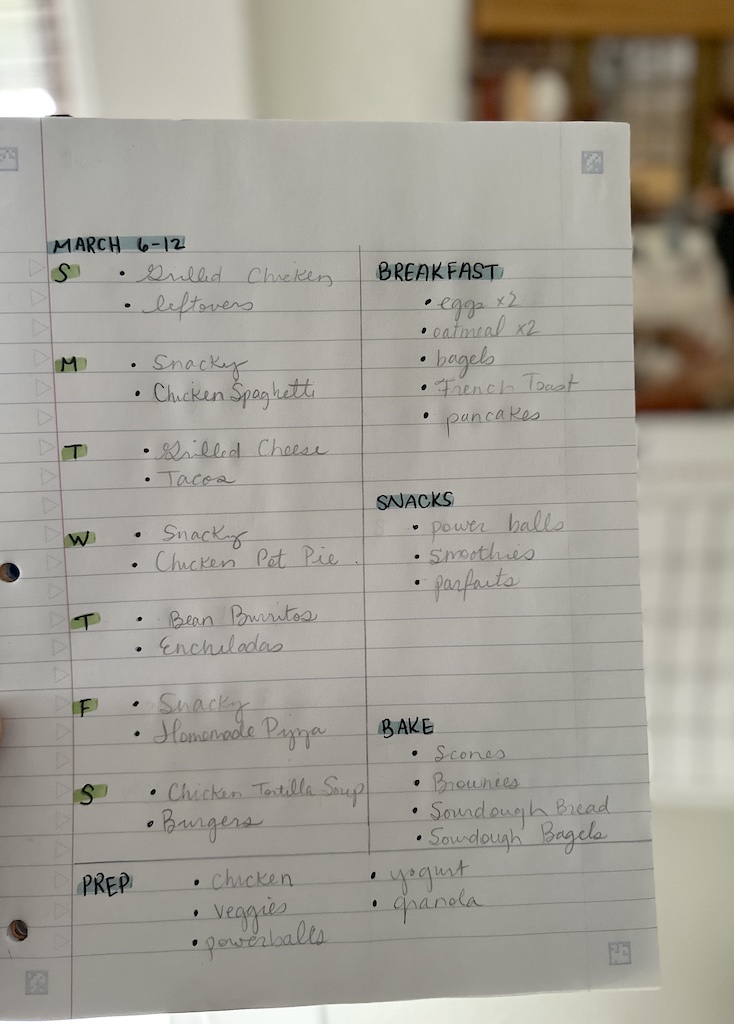A Simple Approach to Family Meal Planning
Family meal planning doesn’t have to be a tedious task that takes hours to complete. It can be simple and enjoyable. It helps to reduce stress throughout the week and keeps your family budget in check. Added benefits are that it helps to keep food waste low. This is not your normal meal planning approach. It’s a way of intuitive cooking and utilizing what you have already to nourish your family!

Meal Prep
Contrary to popular belief, meal prep does not have to take hours. Taking 30 minutes to an hour maximum at the beginning of each week to meal prep a few things will help you so much throughout the week. You will thank yourself later!
A good starting place for what to prep for the week is taking a quick glance through your pantry or refrigerator. Use what you have on hand first! Once you do this a few times, you will get the hang of making your weekly staples so quick. You will also start noticing how much to keep on hand to make these staple recipes.
Some ideas for this are:
- Cook some protein for the week: chicken breasts or ground beef are easy for this. Plan to always keep extra protein in the freezer. Always cooking extra makes meal planning so easy.
- Make a favorite snack, like homemade granola bars. Use whatever seeds, nuts, chocolate available.
- Toss together a casserole to eat as leftovers for lunches or breakfast. Baked oatmeal is a family favorite. Overnight baked French toast is perfect for using up leftover breads.
- Start a pot of broth for the week. **Always save beef or chicken bones and leftover raw veggie scraps in the freezer so you always have broth ingredients on hand.
- Chop up fresh fruits and vegetables. If they them to be used ASAP, use them in a muffin recipe or for smoothies.
- Roast vegetables to throw into meals throughout the week.
Personal Examples From My Sunday Meal Prepping:
- If I have ground beef in my freezer, I will go ahead and plan to have something with ground beef for dinner that night, but I will also go ahead and do 3 pounds of ground beef instead of the one needed right away. Put the two other pounds away for meals throughout the next week.
- I like to make a batch of power balls for my children’s snacks. So cost effective and healthier.
- If I have extra time, I will use the same dishes I used for the power balls and go ahead and make a batch of cookie dough for a treat that night. Store extra dough in the freezer for quick treats.
- Feed my sourdough starter for bread for the upcoming week.
- Sometimes I will start a batch of homemade yogurt in my instant pot. This takes 5 minutes and will be ready the next day. It’s so simple and frugal.
- Chop up carrots and bell peppers for the week ahead.
- If I have just gotten groceries in and was able to get a few rotisserie chickens (beloved amongst large families!), I will go ahead and pick off all the meat (place some in the refrigerator for that week, the rest in the freezer for later meals), and then place the chicken carcass (and all the veggie scraps from prepping those) on the stove for some homemade chicken stock.
- I like to use some of the rotisserie chicken to make high protein chicken burritos for lunches throughout the week.
More meal prep ideas here: How to Create a Nourishing Weekly Meal Prep Rhythm
Hey friends, please don’t forget to follow me over on Instagram! I post more photos and ideas over there.
Sharing this post on Facebook or Pinterest is another great way you can help me out at no cost to you. Thank you!
Weekly Meal Plan
Now that you have spent a little time prepping what you have on hand for the week, it’s time to actually plan out your meals. You now have a wonderful starting point based off what you just prepped!
Write out the days of the week on a paper (or use our free family meal planning printable), and go ahead and spread out the things you just prepped throughout your week. Now continue looking through your pantry and refrigerator, noting what else you need to use up. This is the best starting place for meal planning. Using what you have already have will save your budget and cut the food waste. Start thinking of meals and adding them to your meal plan.
Once your meal plan is complete, start making your grocery list based off what you need to complete the rest of the recipes throughout the week.
I personally plan for:
- 3-5 breakfasts to rotate through
- 6 dinners
- 3-5 lunches
- 3 snacks to spread throughout the week
- 2-4 baked items (fresh bread, muffins, or quick breads)
- I will always have fruits and vegetables to add to meal for sides.
- ** This allows for a few days of leftovers and what I like to call “snacky lunches”.
Personal Example of My Weekly Family Meal Planning:

Or if you’re feeling fancier than me, grab a printable copy here!
Intuitive Cooking
Intuitive cooking comes from experience. It’s an important skill that will strengthen you as a home cook but also stretch your food budget as well. It’s a beautiful thing to become so fully aware of your families likes and dislikes that you barely even need to measure. Intuitive cooking is about using what you have, tasting as you go, and leading with your family’s personal preferences. You don’t need to be tied to a specific recipe. Use recipes as a starting point. This will mainly come from cooking a lot. Good thing we need to eat every single day!
“Great meals rarely start at points that all look like beginnings. They usually pick up where something else leaves off. This is how most of the best things are made - imagine if the world had to begin from scratch each dawn: a tree would never grow, nor would we ever get to see the etchings of gentle rings on a clamshell... Meals' ingredients must be allowed to topple into one another like dominos. Broccoli stems, their florets perfectly boiled in salty water, must be simmered with olive oil and eaten with shaved Parmesan on toast; their leftover cooking liquid kept for the base for soup, studded with other vegetables, drizzled with good olive oil, with the rind of the Parmesan added for heartiness. This continuity is the heart and soul of cooking.”
― Tamar Adler, An Everlasting Meal: Cooking with Economy and Grace
Example of Intuitive Cooking:
- Turning leftovers into an entirely new meal.
- Using the last bits and bobs from the week to create a soup.
- Turning all the leftover veggies into a salad with a homemade dressing.
- Making a scramble with leftover veggies, eggs, and cheese.
- Charcuterie boards using up what’s leftover from the week.
Related Post: 35 Practical Kitchen Tips for Homemakers
Kitchen Staples to Add to Your Shopping List
- Vegetables (fresh and frozen)
- Fruit (fresh, frozen, dried)
- Beef (fresh or frozen)
- Chicken (whole, breasts, thighs)
- Turkey (ground, sliced, whole)
- Pork (chops, sausage, bacon)
- Canned beans (black, white, chickpeas, pinto)
- Canned tomatoes (diced, crushed, paste)
- Jarred pasta sauce
- Broth or bouillon cubes
- Lentils (red and brown)
- Rice (white, brown, jasmine, or arborio)
- Quinoa
- Pasta (any shape)
- Rolled oats
- All-purpose flour
- Baking powder & baking soda
- Cornmeal
- Sugar (white, brown, and/or honey)
- Yeast (for occasional breadmaking)
- Olive oil
- Vegetable or coconut oil
- Apple cider vinegar or white vinegar
- Salt (kosher and sea salt)
- Black pepper
- Garlic powder
- Onion powder
- Paprika (smoked or sweet)
- Italian seasoning
- Cinnamon
- Cumin
- Chili powder
- Dried oregano, thyme, or basil
- Soy sauce or tamari
- Various nuts
- Peanut butter
Family meal planning doesn’t have to be be complicated. Take the time to see what you already have to work with and go from there!
Shop Kitchen Essentials
I hope this resource blesses you and your family this year!
This post contains affiliate links, which means I make a small commission at no extra cost to you. Please read our disclosure policy.
pin it for later…
More Posts To Enjoy:
- 50+ Best Cleaning Quotes and Sayings to Inspire
- How to Dehydrate Sourdough Starter for Long Term Storage
- Growing Garden Mint – How Often to Water Mint Plant & More
- Sourdough Score Design: Tips to Scoring Beautiful Bread
- How to Clean a Wicker Basket – A Simple Guide




